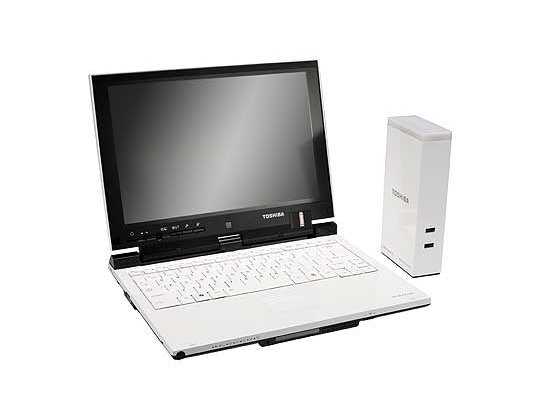Toshiba's Vista laptop opens new horizons
Leading technologies combine in Toshiba's 'Full Monty' PC

One cutting-edge product that's been overlooked by most at CES this week is a new laptop/Tablet PC from Toshiba , the R400. It may be that the Windows Vista tag slapped on it has led people to dismiss it as just another Wintel box but there's plenty inside to merit a quick look.
The R400 will launch in the US at the end of the month with a choice of major components, such as CPU and memory, starting at $2,599 (£1,340) and will hit the UK too within the first quarter of the year. Aside from the appealing black and white design, there are several attention-grabbing technologies.
Cutting the ties
First is the UWB (Ultra Wideband) breakout box that is the 2007 equivalent of a port replicator without wires - users plug, for example, a video camera into the box and that beams its content over to the PC.
UWB replaces USB or FireWire cables to transfer large amounts of data between devices and the computer at comparable speeds, something the already-popular Bluetooth can't manage. The bandwidth possible using UWB stretches all the way to 480Mbit/s, so even wire-free HD TV is possible.
Then there's the full spectrum of methods for getting online - all kinds of Wi-Fi are available alongside the mobile phone EV-DO data standard, from which the Toshiba software automatically chooses the best available route to the internet.
Lastly, a couple of minor hardware frills complete a nice package. The LCD display is backlit by a layer of LEDs to produce an even, bright image, while an LED panel on the front of the notebook called, lamely, 'The Edge' displays details about new emails, battery life and the like using Microsoft's Active Notifications (AN) technology. For the price, this is one desirable little package. J Mark Lytle
Sign up for breaking news, reviews, opinion, top tech deals, and more.
Tech.co.uk was the former name of TechRadar.com. Its staff were at the forefront of the digital publishing revolution, and spearheaded the move to bring consumer technology journalism to its natural home – online. Many of the current TechRadar staff started life a Tech.co.uk staff writer, covering everything from the emerging smartphone market to the evolving market of personal computers. Think of it as the building blocks of the TechRadar you love today.